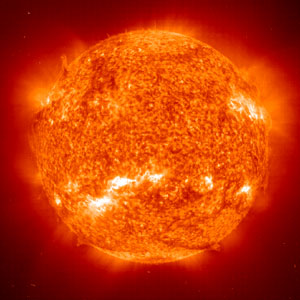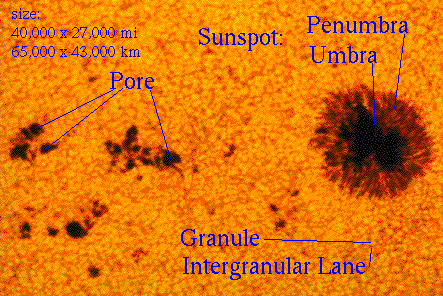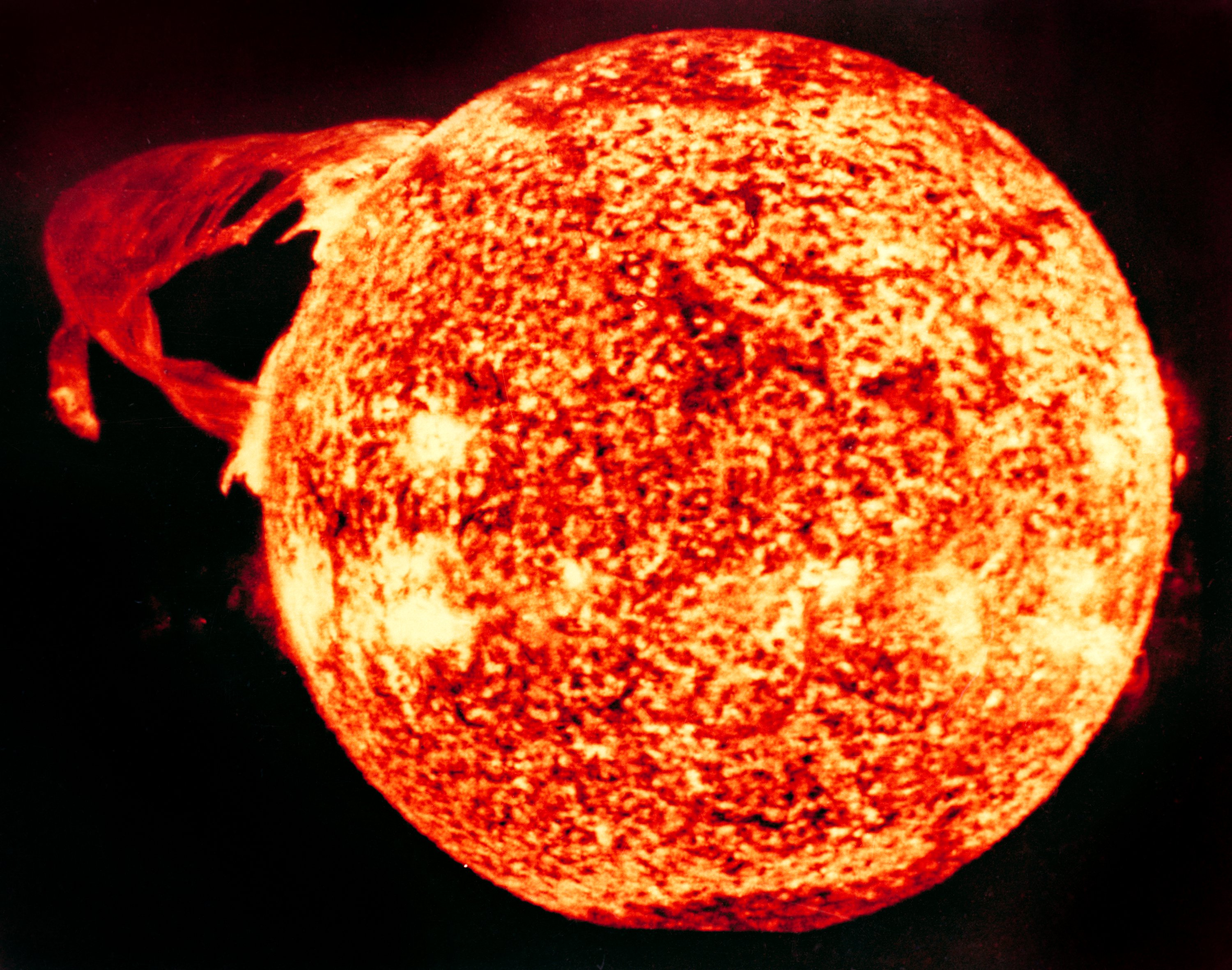All About The Sun

In the past, the Sun was surrounded by many myths and legends. The Greeks believed that the Sun was carried by a golden chariot driven by the god Helios. Some civilizations believed that lunar eclipses occurred when the sun was being eaten by a dragon, while others believed they occurred when the sun and moon were fighting and the sun had been knocked out. With modern astronomy, we can now solve many of the mysteries surrounding the sun.
A (Safe) Look At The Sun
The Sun by the Numbers
- Average Distance from Earth: 1 AU (1.495979 X 10^8 km)
- Average Angular Diameter: 0.53 degrees (32 minutes of arc)
- Period of rotation: Varies by latitude. 25.38 days at equator.
- Apparent visual magnitude: -26.74
- Absolute magnitude: 4.83
- Spectral type: G2 V
- Central temperature: 15 X 10^6 K
- Surface temperature: 5800 K
- Luminosity: 3.826 X 10^26 J/s
- Escape velocity at surface: 617.7 km/s
- Average density: 1.409 grams per cubic centimeter
- Mass: 1.989 X 10^30 kg
- Radius: 6.9599 X 10^5 km
Formation Of Our Sun
The Sun formed approximately 4.6 billion years ago from a cloud of dust and gas known as the solar nebula. This nebula was spinning rapidly and flattened into a disk. Through a gradual process fueled by gravity, the dust and gas began to gather into clumps. The largest clump at the center of the future solar system received 99.8% of the material in the nebula and, when it became heavy and dense enough, the pressure triggered nuclear reactions in the core. This large ball of gas became our sun.
The Sun’s Place in the Cosmos
For a long time, humans believed that Earth was the center of the cosmos and the Sun, Moon, stars and planets were held in spheres that revolved around it. Astronomers worked out equations to predict the positions of celestial objects, but they proved inaccurate over long periods of time. In the 16th century, Copernicus introduced a revolutionary new model in which the Sun, not Earth, was the center of the universe. The new model was inaccurate, with perfectly circular orbits, but helped explain why planets sometimes appeared to reverse course in the sky.
Like many controversial new ideas, this one took time to be widely accepted. While studying Mars, an astronomer named Johannes Kepler realized that Copernicus’ model, while an improvement, didn’t quite fit with Mars’ motion across the sky. He helped make the model more accurate when he introduced the concept that the planets’ orbits were elliptical. Within a century of Copernicus’ introduction of his original model, the idea that the sun is the center of the solar system came to be widely accepted by the scientific community.
As telescopes improved and astronomers made new discoveries, the sun was pushed from the center of the cosmos. It is located about 26,000 light years from the center of our galaxy, the Milky Way, in the Orion arm.
Sunspots

Galileo Galilei was the first to record observations of dark blotches on the sun. The idea that the sun didn’t have a perfectly uniform surface was nearly as controversial as the idea that it was the center of the solar system and many of his associates refused to look through his telescope in the fear that they might be fooled. These blotches came to be called “sunspots.”
These sunspots are darker, cooler places on the sun caused by its magnetic field. They typically come in pairs in places where the magnetic field protrude from its surface. “Cooler” is, of course, relative. Sunspots have a temperature of 4240 K and emit enough radiation to outshine a full moon.
The number of sunspots rise and fall in a cycle lasting about 11 years. The maximum and minimum number of sunspots can vary from cycle to cycle. One historic low is known as the Maunder minimum, a period of 1645 to 1715 when very few sunspots were observed. This minimum coincides with the “Little Ice Age,” a period of unusually cool weather lasting from 1500 to 1850. Ongoing observations suggest a link between solar activity, sun spots and climate on Earth.
The Solar Constant
The Solar Constant is a measurement of the amount of solar energy that falls on one square meter of Earth’s surface every second. Astronomers correct for absorption of certain wavelengths by the atmosphere and count all wavelengths from X-rays to radio waves. The solar constant can vary and large variations over long periods of time can lead to changes in Earth’s climate.
Solar Flares

Solar astronomer Richard Carrington was the first to observe a solar flare on September 1, 1859. He was recording sunspots when two bright flares of light in the middle of the group of sunspots suddenly appeared on his screen. He called for a friend, but they faded quickly.
Solar flares are eruptions of magnetic energy that have built up in the solar atmosphere. They emit energy through the entire electromagnetic spectrum. An average flare emits 10^27 ergs per second. A large flare can emit up to 10^32 ergs. By comparison, one Calorie is equal to 4.2 X 10^10 ergs. Flares extend out into the Corona and can heat the gas to between 10 million Kelvin and 100 million Kelvin, depending on the size of the flare.
A solar flare has three stages. The first stage is known as the precursor stage, in which the magnetic energy is triggered. This can be detected in the soft X-ray range, as in the picture above. The second stage is known as the impulsive stage. Protons and electrons are accelerated to 1 million electric volts, or 1 MeV. The flare emits hard X-rays, radio waves and gamma rays. During the third stage, known as the decay stage, the flare is dying off and soft x-rays are again detected as they build up and decay. Each stage can last for as little as a few seconds or as long as an hour. NASA’s Orbiting Solar Observatory recently discovered evidence of a fourth “aftershock” phase called the Late Phase Flare that may be be more powerful than the initial flare by a factor of four.
Like sunspots, the frequency of solar flares occurs on an 11-year cycle. Special equipment is required to observe a solar flare. They can damage electronics in Earth orbit and on the ground, but only if they are aimed in our direction.
Nuclear Fusion in the Sun
The sun’s power is produced by nuclear fusion at its core. The gas in the core is made up of ionized hydrogen and helium atoms and electrons that are not attached to atomic nuclei. In all atoms, the nuclei are made up of protons and, sometimes, neutrons bound together by the strong force, a very short-range but powerful force of nature. Its counterpart, the weak force, is primarily associated with radioactive decay. Hydrogen atoms contains one proton in their nuclei and helium atoms have two protons.
Nuclear fusion in the sun works by fusing hydrogen atoms into helium atoms. The commonsense, ordinary mathematical approach would suggest that it takes two hydrogen atoms to make a helium atom. In reality, it takes four hydrogen atoms to make one helium atom using hydrogen fusion. The process is called a proton-proton chain and consists of three steps:
1H + 1H –> 2H + e + v
Two hydrogen nuclei combine to form a heavy hydrogen nucleus called deuterium. This reaction also emits a small, positively charged particle called a positron, and a particle with a very low mass and a velocity that is almost the speed of light known as a neutrino.
2H + 1H –> 3He + y
The deuterium collides with another proton to produce a lightweight helium nucleus and a burst of gamma radiation.
3He + 3He –> 4He + 1H + 1H
Two light helium nuclei collide to form the nucleus of a normal helium atom and two hydrogen atoms. As you may have noticed, the end result has lost a little mass in the form of neutrinos and positrons and a little energy in the form of gamma radiation. The difference looks a little like this:
4 hydrogen nuclei: 6.693 X 10^-27 kg minus 1 Helium nucleus: 6.645 X 10^27 kg equals 0.048 X 10^27 Kg
The entire process of converting four hydrogen nuclei into one helium nucleus produces 0.43 X 10^-11 Joules of energy. This is a very small amount and the sun needs 10^38 such reactions per second just to remain stable as a huge ball of glowing hot plasma.
Will Our Sun Run Out Of Fuel?
Inevitably, the sun will run out of hydrogen to convert into helium. This is estimated to happen in approximately 5 billion years. At that point, it is expected to swell up into a red giant star, engulfing Mercury, Venus and possibly Earth. Earth will certainly be scorched to the point that life will be impossible. It will then start converting helium into carbon. When that runs out, it will then shed its outer layers and shrink to an Earth-sized white dwarf that, some scientists now say, will be a crystal white dwarf containing high levels of carbon and oxygen in its core. The white dwarf will still glow and emit heat for a long time, possibly as long as a few billion years, but will no longer be producing energy with fusion. It will gradually cool and become a black dwarf.









